Organizational Behavior: Job Design, Motivation, and Performance
VerifiedAdded on 2020/05/28
|8
|2340
|384
Essay
AI Summary
This essay examines organizational behavior (OB) and its impact on employee performance. It explores the influence of job design, working conditions, goal setting, motivation, and rewards on productivity. The essay discusses various OB theories, including Theories X, Y, and Z, Maslow's Hierarchy of Needs, Expectancy Theory, and Herzberg's Motivation-Hygiene theory, and their relevance in the workplace. It further analyzes the role of organizational culture, work ethics, and the impact of management practices on employee behavior and performance. The essay emphasizes the importance of employee empowerment, job engagement, and management strategies in enhancing overall productivity and achieving organizational goals. References from various researchers are included to support the arguments presented.

Running head: ORGANIZATIONAL BEHAVIOR
In order to encourage productive performance from employees, care needs to be taken with
the design of jobs, working conditions, setting of goals, motivation and rewards.
Name of the Student
Name of the University
Author Note
In order to encourage productive performance from employees, care needs to be taken with
the design of jobs, working conditions, setting of goals, motivation and rewards.
Name of the Student
Name of the University
Author Note
Paraphrase This Document
Need a fresh take? Get an instant paraphrase of this document with our AI Paraphraser
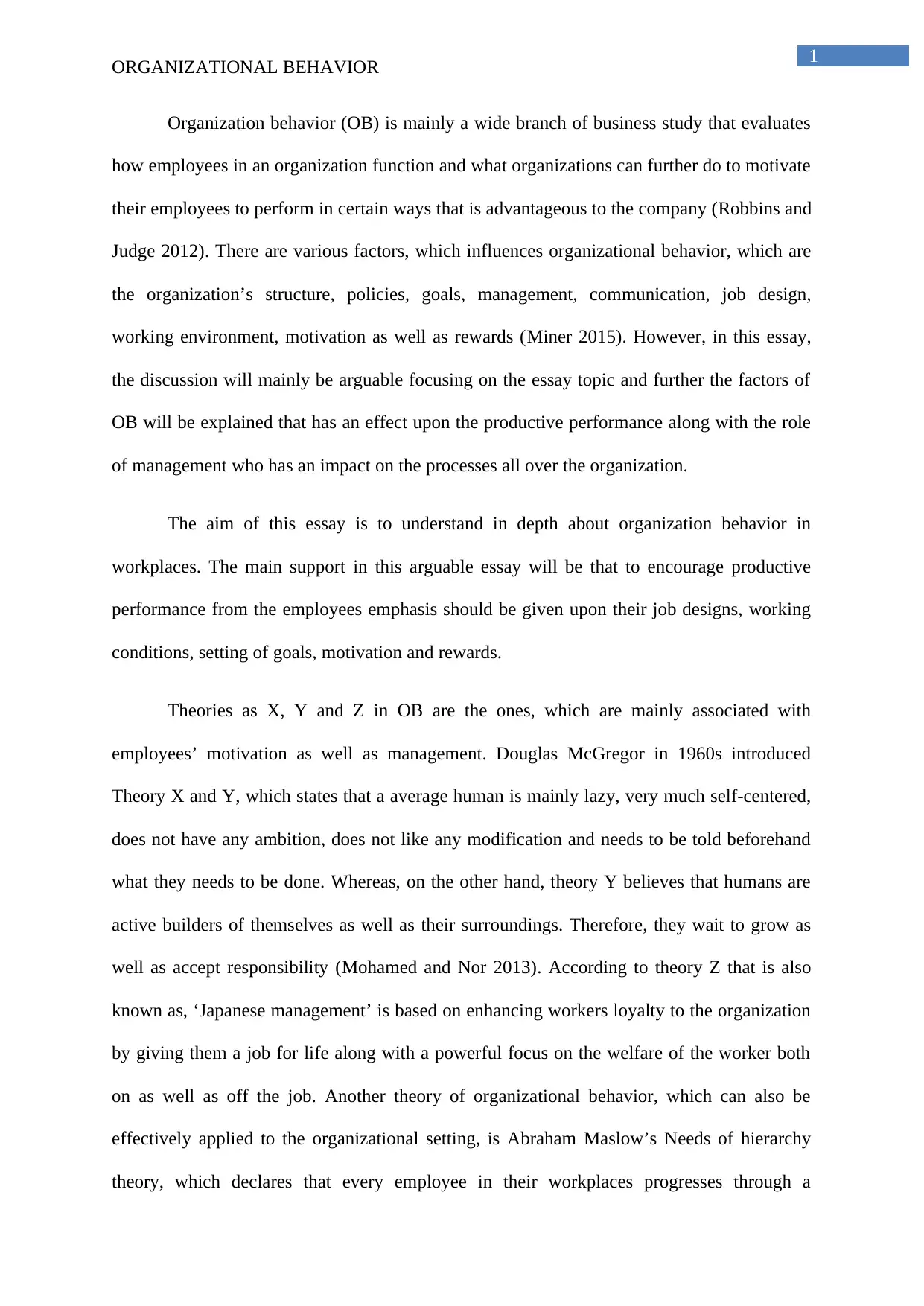
1
ORGANIZATIONAL BEHAVIOR
Organization behavior (OB) is mainly a wide branch of business study that evaluates
how employees in an organization function and what organizations can further do to motivate
their employees to perform in certain ways that is advantageous to the company (Robbins and
Judge 2012). There are various factors, which influences organizational behavior, which are
the organization’s structure, policies, goals, management, communication, job design,
working environment, motivation as well as rewards (Miner 2015). However, in this essay,
the discussion will mainly be arguable focusing on the essay topic and further the factors of
OB will be explained that has an effect upon the productive performance along with the role
of management who has an impact on the processes all over the organization.
The aim of this essay is to understand in depth about organization behavior in
workplaces. The main support in this arguable essay will be that to encourage productive
performance from the employees emphasis should be given upon their job designs, working
conditions, setting of goals, motivation and rewards.
Theories as X, Y and Z in OB are the ones, which are mainly associated with
employees’ motivation as well as management. Douglas McGregor in 1960s introduced
Theory X and Y, which states that a average human is mainly lazy, very much self-centered,
does not have any ambition, does not like any modification and needs to be told beforehand
what they needs to be done. Whereas, on the other hand, theory Y believes that humans are
active builders of themselves as well as their surroundings. Therefore, they wait to grow as
well as accept responsibility (Mohamed and Nor 2013). According to theory Z that is also
known as, ‘Japanese management’ is based on enhancing workers loyalty to the organization
by giving them a job for life along with a powerful focus on the welfare of the worker both
on as well as off the job. Another theory of organizational behavior, which can also be
effectively applied to the organizational setting, is Abraham Maslow’s Needs of hierarchy
theory, which declares that every employee in their workplaces progresses through a
ORGANIZATIONAL BEHAVIOR
Organization behavior (OB) is mainly a wide branch of business study that evaluates
how employees in an organization function and what organizations can further do to motivate
their employees to perform in certain ways that is advantageous to the company (Robbins and
Judge 2012). There are various factors, which influences organizational behavior, which are
the organization’s structure, policies, goals, management, communication, job design,
working environment, motivation as well as rewards (Miner 2015). However, in this essay,
the discussion will mainly be arguable focusing on the essay topic and further the factors of
OB will be explained that has an effect upon the productive performance along with the role
of management who has an impact on the processes all over the organization.
The aim of this essay is to understand in depth about organization behavior in
workplaces. The main support in this arguable essay will be that to encourage productive
performance from the employees emphasis should be given upon their job designs, working
conditions, setting of goals, motivation and rewards.
Theories as X, Y and Z in OB are the ones, which are mainly associated with
employees’ motivation as well as management. Douglas McGregor in 1960s introduced
Theory X and Y, which states that a average human is mainly lazy, very much self-centered,
does not have any ambition, does not like any modification and needs to be told beforehand
what they needs to be done. Whereas, on the other hand, theory Y believes that humans are
active builders of themselves as well as their surroundings. Therefore, they wait to grow as
well as accept responsibility (Mohamed and Nor 2013). According to theory Z that is also
known as, ‘Japanese management’ is based on enhancing workers loyalty to the organization
by giving them a job for life along with a powerful focus on the welfare of the worker both
on as well as off the job. Another theory of organizational behavior, which can also be
effectively applied to the organizational setting, is Abraham Maslow’s Needs of hierarchy
theory, which declares that every employee in their workplaces progresses through a
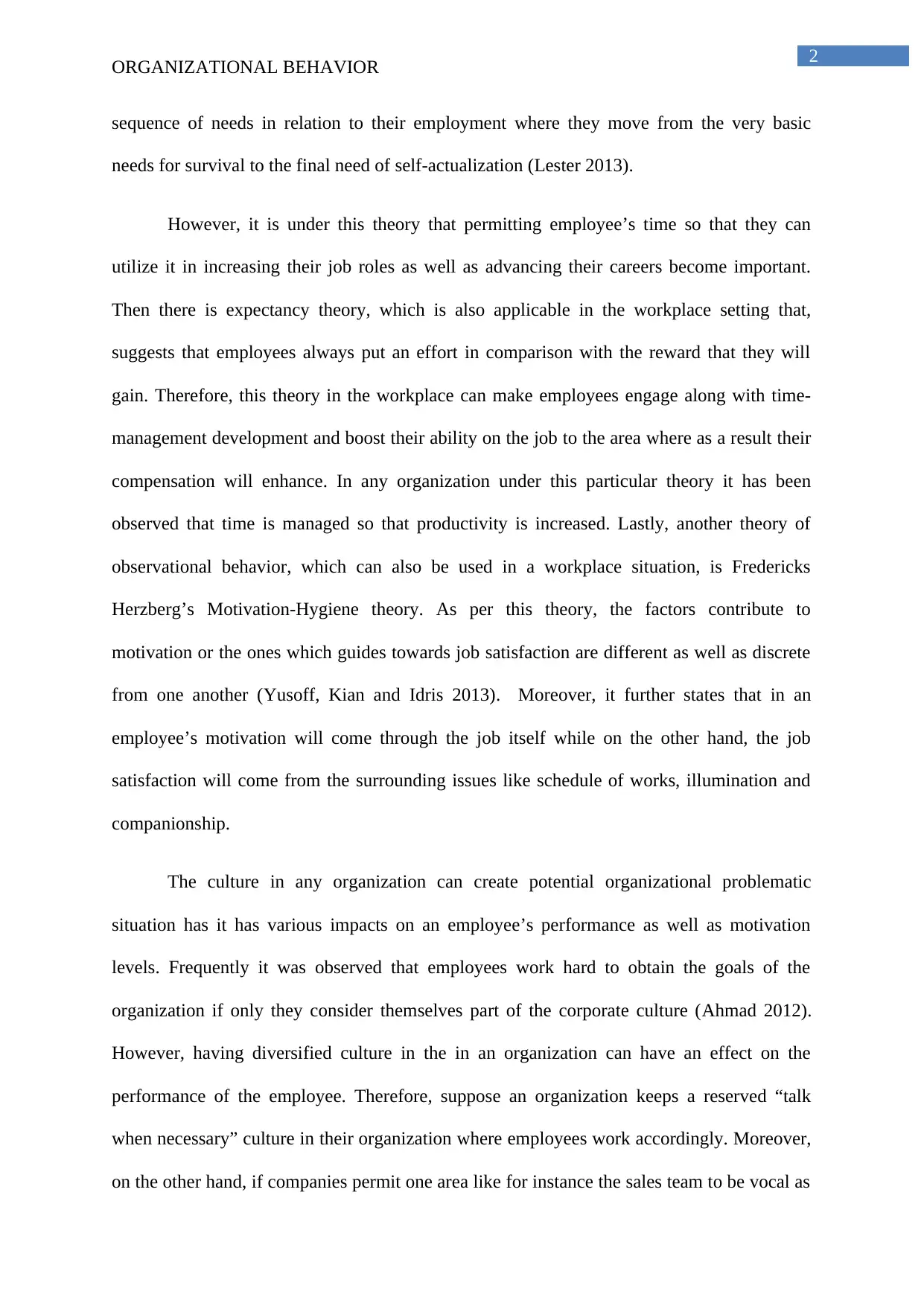
2
ORGANIZATIONAL BEHAVIOR
sequence of needs in relation to their employment where they move from the very basic
needs for survival to the final need of self-actualization (Lester 2013).
However, it is under this theory that permitting employee’s time so that they can
utilize it in increasing their job roles as well as advancing their careers become important.
Then there is expectancy theory, which is also applicable in the workplace setting that,
suggests that employees always put an effort in comparison with the reward that they will
gain. Therefore, this theory in the workplace can make employees engage along with time-
management development and boost their ability on the job to the area where as a result their
compensation will enhance. In any organization under this particular theory it has been
observed that time is managed so that productivity is increased. Lastly, another theory of
observational behavior, which can also be used in a workplace situation, is Fredericks
Herzberg’s Motivation-Hygiene theory. As per this theory, the factors contribute to
motivation or the ones which guides towards job satisfaction are different as well as discrete
from one another (Yusoff, Kian and Idris 2013). Moreover, it further states that in an
employee’s motivation will come through the job itself while on the other hand, the job
satisfaction will come from the surrounding issues like schedule of works, illumination and
companionship.
The culture in any organization can create potential organizational problematic
situation has it has various impacts on an employee’s performance as well as motivation
levels. Frequently it was observed that employees work hard to obtain the goals of the
organization if only they consider themselves part of the corporate culture (Ahmad 2012).
However, having diversified culture in the in an organization can have an effect on the
performance of the employee. Therefore, suppose an organization keeps a reserved “talk
when necessary” culture in their organization where employees work accordingly. Moreover,
on the other hand, if companies permit one area like for instance the sales team to be vocal as
ORGANIZATIONAL BEHAVIOR
sequence of needs in relation to their employment where they move from the very basic
needs for survival to the final need of self-actualization (Lester 2013).
However, it is under this theory that permitting employee’s time so that they can
utilize it in increasing their job roles as well as advancing their careers become important.
Then there is expectancy theory, which is also applicable in the workplace setting that,
suggests that employees always put an effort in comparison with the reward that they will
gain. Therefore, this theory in the workplace can make employees engage along with time-
management development and boost their ability on the job to the area where as a result their
compensation will enhance. In any organization under this particular theory it has been
observed that time is managed so that productivity is increased. Lastly, another theory of
observational behavior, which can also be used in a workplace situation, is Fredericks
Herzberg’s Motivation-Hygiene theory. As per this theory, the factors contribute to
motivation or the ones which guides towards job satisfaction are different as well as discrete
from one another (Yusoff, Kian and Idris 2013). Moreover, it further states that in an
employee’s motivation will come through the job itself while on the other hand, the job
satisfaction will come from the surrounding issues like schedule of works, illumination and
companionship.
The culture in any organization can create potential organizational problematic
situation has it has various impacts on an employee’s performance as well as motivation
levels. Frequently it was observed that employees work hard to obtain the goals of the
organization if only they consider themselves part of the corporate culture (Ahmad 2012).
However, having diversified culture in the in an organization can have an effect on the
performance of the employee. Therefore, suppose an organization keeps a reserved “talk
when necessary” culture in their organization where employees work accordingly. Moreover,
on the other hand, if companies permit one area like for instance the sales team to be vocal as
⊘ This is a preview!⊘
Do you want full access?
Subscribe today to unlock all pages.

Trusted by 1+ million students worldwide
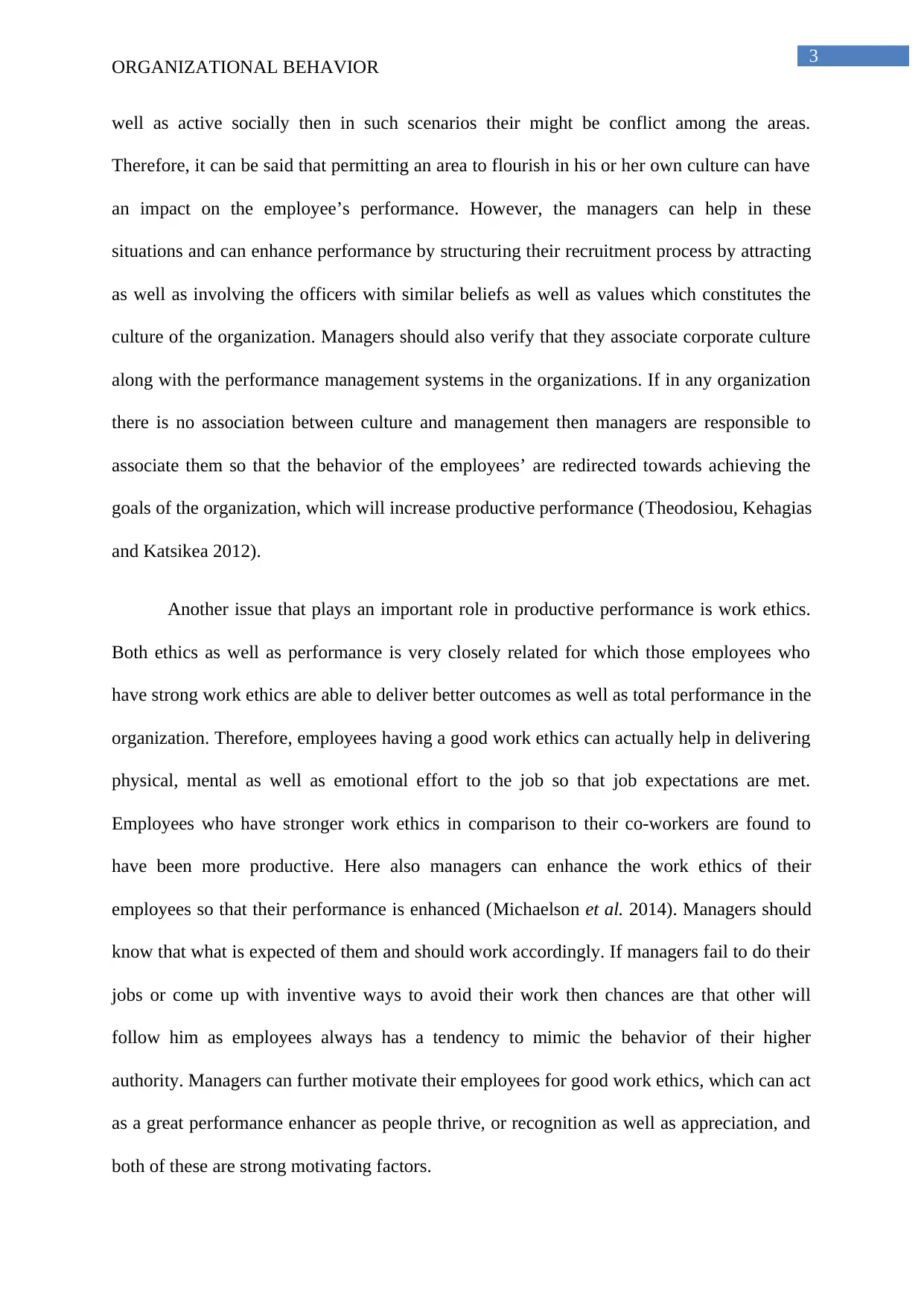
3
ORGANIZATIONAL BEHAVIOR
well as active socially then in such scenarios their might be conflict among the areas.
Therefore, it can be said that permitting an area to flourish in his or her own culture can have
an impact on the employee’s performance. However, the managers can help in these
situations and can enhance performance by structuring their recruitment process by attracting
as well as involving the officers with similar beliefs as well as values which constitutes the
culture of the organization. Managers should also verify that they associate corporate culture
along with the performance management systems in the organizations. If in any organization
there is no association between culture and management then managers are responsible to
associate them so that the behavior of the employees’ are redirected towards achieving the
goals of the organization, which will increase productive performance (Theodosiou, Kehagias
and Katsikea 2012).
Another issue that plays an important role in productive performance is work ethics.
Both ethics as well as performance is very closely related for which those employees who
have strong work ethics are able to deliver better outcomes as well as total performance in the
organization. Therefore, employees having a good work ethics can actually help in delivering
physical, mental as well as emotional effort to the job so that job expectations are met.
Employees who have stronger work ethics in comparison to their co-workers are found to
have been more productive. Here also managers can enhance the work ethics of their
employees so that their performance is enhanced (Michaelson et al. 2014). Managers should
know that what is expected of them and should work accordingly. If managers fail to do their
jobs or come up with inventive ways to avoid their work then chances are that other will
follow him as employees always has a tendency to mimic the behavior of their higher
authority. Managers can further motivate their employees for good work ethics, which can act
as a great performance enhancer as people thrive, or recognition as well as appreciation, and
both of these are strong motivating factors.
ORGANIZATIONAL BEHAVIOR
well as active socially then in such scenarios their might be conflict among the areas.
Therefore, it can be said that permitting an area to flourish in his or her own culture can have
an impact on the employee’s performance. However, the managers can help in these
situations and can enhance performance by structuring their recruitment process by attracting
as well as involving the officers with similar beliefs as well as values which constitutes the
culture of the organization. Managers should also verify that they associate corporate culture
along with the performance management systems in the organizations. If in any organization
there is no association between culture and management then managers are responsible to
associate them so that the behavior of the employees’ are redirected towards achieving the
goals of the organization, which will increase productive performance (Theodosiou, Kehagias
and Katsikea 2012).
Another issue that plays an important role in productive performance is work ethics.
Both ethics as well as performance is very closely related for which those employees who
have strong work ethics are able to deliver better outcomes as well as total performance in the
organization. Therefore, employees having a good work ethics can actually help in delivering
physical, mental as well as emotional effort to the job so that job expectations are met.
Employees who have stronger work ethics in comparison to their co-workers are found to
have been more productive. Here also managers can enhance the work ethics of their
employees so that their performance is enhanced (Michaelson et al. 2014). Managers should
know that what is expected of them and should work accordingly. If managers fail to do their
jobs or come up with inventive ways to avoid their work then chances are that other will
follow him as employees always has a tendency to mimic the behavior of their higher
authority. Managers can further motivate their employees for good work ethics, which can act
as a great performance enhancer as people thrive, or recognition as well as appreciation, and
both of these are strong motivating factors.
Paraphrase This Document
Need a fresh take? Get an instant paraphrase of this document with our AI Paraphraser
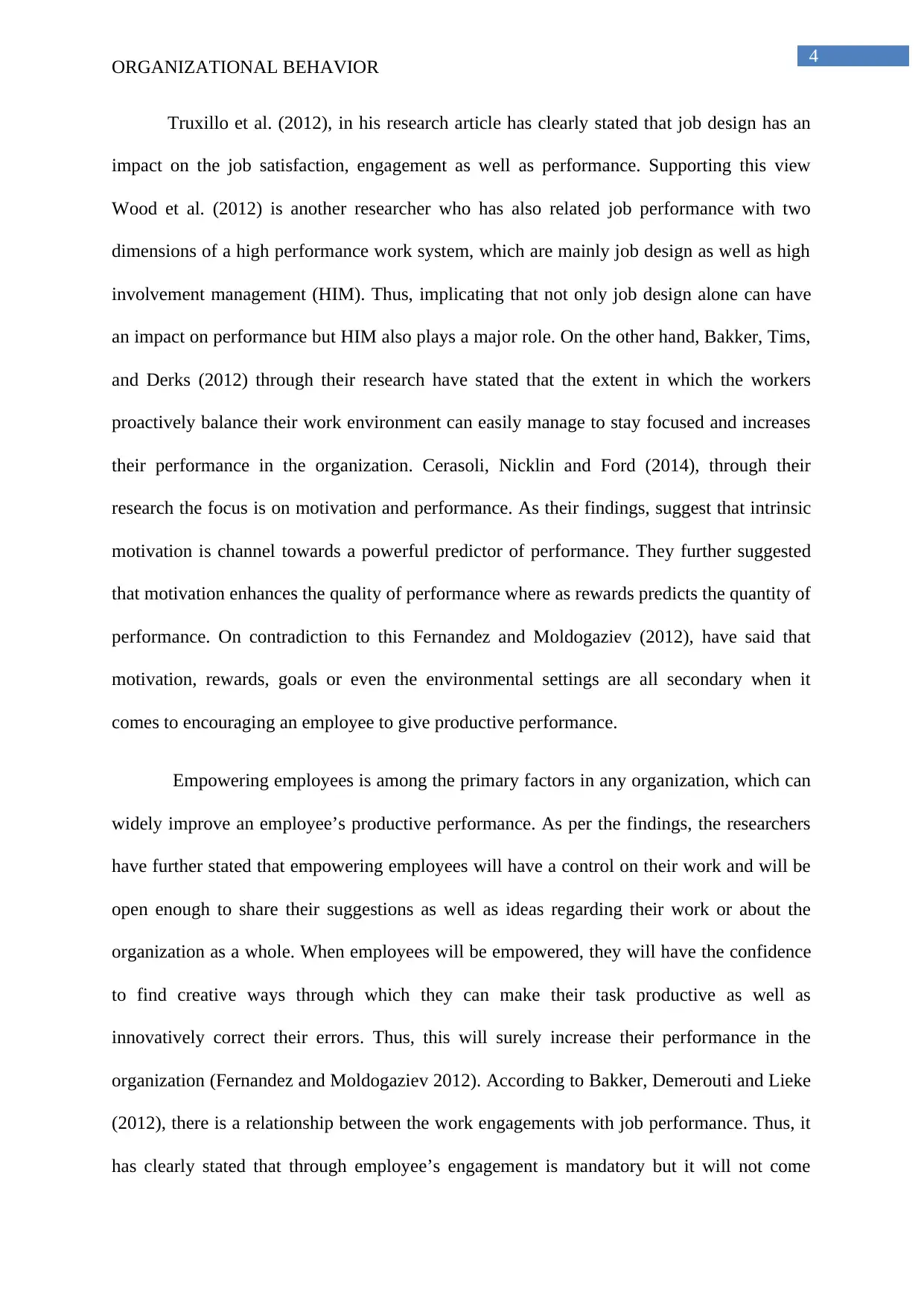
4
ORGANIZATIONAL BEHAVIOR
Truxillo et al. (2012), in his research article has clearly stated that job design has an
impact on the job satisfaction, engagement as well as performance. Supporting this view
Wood et al. (2012) is another researcher who has also related job performance with two
dimensions of a high performance work system, which are mainly job design as well as high
involvement management (HIM). Thus, implicating that not only job design alone can have
an impact on performance but HIM also plays a major role. On the other hand, Bakker, Tims,
and Derks (2012) through their research have stated that the extent in which the workers
proactively balance their work environment can easily manage to stay focused and increases
their performance in the organization. Cerasoli, Nicklin and Ford (2014), through their
research the focus is on motivation and performance. As their findings, suggest that intrinsic
motivation is channel towards a powerful predictor of performance. They further suggested
that motivation enhances the quality of performance where as rewards predicts the quantity of
performance. On contradiction to this Fernandez and Moldogaziev (2012), have said that
motivation, rewards, goals or even the environmental settings are all secondary when it
comes to encouraging an employee to give productive performance.
Empowering employees is among the primary factors in any organization, which can
widely improve an employee’s productive performance. As per the findings, the researchers
have further stated that empowering employees will have a control on their work and will be
open enough to share their suggestions as well as ideas regarding their work or about the
organization as a whole. When employees will be empowered, they will have the confidence
to find creative ways through which they can make their task productive as well as
innovatively correct their errors. Thus, this will surely increase their performance in the
organization (Fernandez and Moldogaziev 2012). According to Bakker, Demerouti and Lieke
(2012), there is a relationship between the work engagements with job performance. Thus, it
has clearly stated that through employee’s engagement is mandatory but it will not come
ORGANIZATIONAL BEHAVIOR
Truxillo et al. (2012), in his research article has clearly stated that job design has an
impact on the job satisfaction, engagement as well as performance. Supporting this view
Wood et al. (2012) is another researcher who has also related job performance with two
dimensions of a high performance work system, which are mainly job design as well as high
involvement management (HIM). Thus, implicating that not only job design alone can have
an impact on performance but HIM also plays a major role. On the other hand, Bakker, Tims,
and Derks (2012) through their research have stated that the extent in which the workers
proactively balance their work environment can easily manage to stay focused and increases
their performance in the organization. Cerasoli, Nicklin and Ford (2014), through their
research the focus is on motivation and performance. As their findings, suggest that intrinsic
motivation is channel towards a powerful predictor of performance. They further suggested
that motivation enhances the quality of performance where as rewards predicts the quantity of
performance. On contradiction to this Fernandez and Moldogaziev (2012), have said that
motivation, rewards, goals or even the environmental settings are all secondary when it
comes to encouraging an employee to give productive performance.
Empowering employees is among the primary factors in any organization, which can
widely improve an employee’s productive performance. As per the findings, the researchers
have further stated that empowering employees will have a control on their work and will be
open enough to share their suggestions as well as ideas regarding their work or about the
organization as a whole. When employees will be empowered, they will have the confidence
to find creative ways through which they can make their task productive as well as
innovatively correct their errors. Thus, this will surely increase their performance in the
organization (Fernandez and Moldogaziev 2012). According to Bakker, Demerouti and Lieke
(2012), there is a relationship between the work engagements with job performance. Thus, it
has clearly stated that through employee’s engagement is mandatory but it will not come

5
ORGANIZATIONAL BEHAVIOR
from the workplace environment alone rather the work itself needs to have certain source of
interest which will make the employee more hard working, careful as well as goal oriented
which in a way enhances productive performance of the employee. The findings of this
research have further stated that work engagement has a positive correlation with the
performance as well as active learning mainly with employees who are high in their
conscientiousness.
Thus, to conclude the essay it can be said that a depth of understanding regarding
organizational behavior in the workplace has been reached. X, Y and Z, theories in OB have
bestowed the idea that these are mainly connected with employee’s motivation in
organizations. Moreover, there is also another theory, which was introduced by Abraham
Maslow known as Hierarchy of Needs theory. This theory has stated that employees in any
workplace progresses through the ladder of needs. Moreover, as the literature states that
though factors like job design, working conditions, goals, motivation as well as rewards
encourages productive performance, but other factors are there as well like job engagement,
employee empowerment as well as management motivates employees to give their best and
increase their level of performance.
ORGANIZATIONAL BEHAVIOR
from the workplace environment alone rather the work itself needs to have certain source of
interest which will make the employee more hard working, careful as well as goal oriented
which in a way enhances productive performance of the employee. The findings of this
research have further stated that work engagement has a positive correlation with the
performance as well as active learning mainly with employees who are high in their
conscientiousness.
Thus, to conclude the essay it can be said that a depth of understanding regarding
organizational behavior in the workplace has been reached. X, Y and Z, theories in OB have
bestowed the idea that these are mainly connected with employee’s motivation in
organizations. Moreover, there is also another theory, which was introduced by Abraham
Maslow known as Hierarchy of Needs theory. This theory has stated that employees in any
workplace progresses through the ladder of needs. Moreover, as the literature states that
though factors like job design, working conditions, goals, motivation as well as rewards
encourages productive performance, but other factors are there as well like job engagement,
employee empowerment as well as management motivates employees to give their best and
increase their level of performance.
⊘ This is a preview!⊘
Do you want full access?
Subscribe today to unlock all pages.

Trusted by 1+ million students worldwide
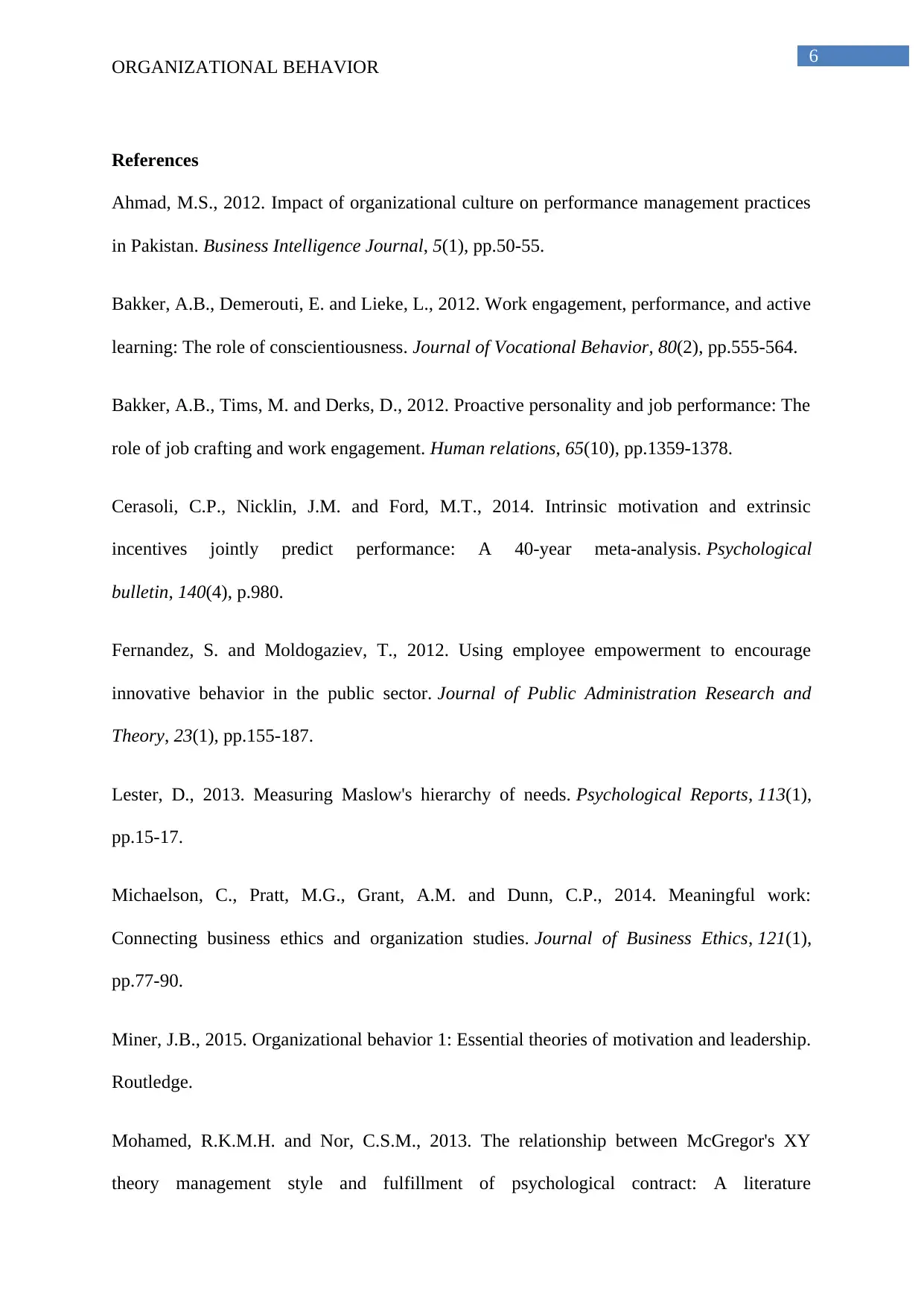
6
ORGANIZATIONAL BEHAVIOR
References
Ahmad, M.S., 2012. Impact of organizational culture on performance management practices
in Pakistan. Business Intelligence Journal, 5(1), pp.50-55.
Bakker, A.B., Demerouti, E. and Lieke, L., 2012. Work engagement, performance, and active
learning: The role of conscientiousness. Journal of Vocational Behavior, 80(2), pp.555-564.
Bakker, A.B., Tims, M. and Derks, D., 2012. Proactive personality and job performance: The
role of job crafting and work engagement. Human relations, 65(10), pp.1359-1378.
Cerasoli, C.P., Nicklin, J.M. and Ford, M.T., 2014. Intrinsic motivation and extrinsic
incentives jointly predict performance: A 40-year meta-analysis. Psychological
bulletin, 140(4), p.980.
Fernandez, S. and Moldogaziev, T., 2012. Using employee empowerment to encourage
innovative behavior in the public sector. Journal of Public Administration Research and
Theory, 23(1), pp.155-187.
Lester, D., 2013. Measuring Maslow's hierarchy of needs. Psychological Reports, 113(1),
pp.15-17.
Michaelson, C., Pratt, M.G., Grant, A.M. and Dunn, C.P., 2014. Meaningful work:
Connecting business ethics and organization studies. Journal of Business Ethics, 121(1),
pp.77-90.
Miner, J.B., 2015. Organizational behavior 1: Essential theories of motivation and leadership.
Routledge.
Mohamed, R.K.M.H. and Nor, C.S.M., 2013. The relationship between McGregor's XY
theory management style and fulfillment of psychological contract: A literature
ORGANIZATIONAL BEHAVIOR
References
Ahmad, M.S., 2012. Impact of organizational culture on performance management practices
in Pakistan. Business Intelligence Journal, 5(1), pp.50-55.
Bakker, A.B., Demerouti, E. and Lieke, L., 2012. Work engagement, performance, and active
learning: The role of conscientiousness. Journal of Vocational Behavior, 80(2), pp.555-564.
Bakker, A.B., Tims, M. and Derks, D., 2012. Proactive personality and job performance: The
role of job crafting and work engagement. Human relations, 65(10), pp.1359-1378.
Cerasoli, C.P., Nicklin, J.M. and Ford, M.T., 2014. Intrinsic motivation and extrinsic
incentives jointly predict performance: A 40-year meta-analysis. Psychological
bulletin, 140(4), p.980.
Fernandez, S. and Moldogaziev, T., 2012. Using employee empowerment to encourage
innovative behavior in the public sector. Journal of Public Administration Research and
Theory, 23(1), pp.155-187.
Lester, D., 2013. Measuring Maslow's hierarchy of needs. Psychological Reports, 113(1),
pp.15-17.
Michaelson, C., Pratt, M.G., Grant, A.M. and Dunn, C.P., 2014. Meaningful work:
Connecting business ethics and organization studies. Journal of Business Ethics, 121(1),
pp.77-90.
Miner, J.B., 2015. Organizational behavior 1: Essential theories of motivation and leadership.
Routledge.
Mohamed, R.K.M.H. and Nor, C.S.M., 2013. The relationship between McGregor's XY
theory management style and fulfillment of psychological contract: A literature
Paraphrase This Document
Need a fresh take? Get an instant paraphrase of this document with our AI Paraphraser
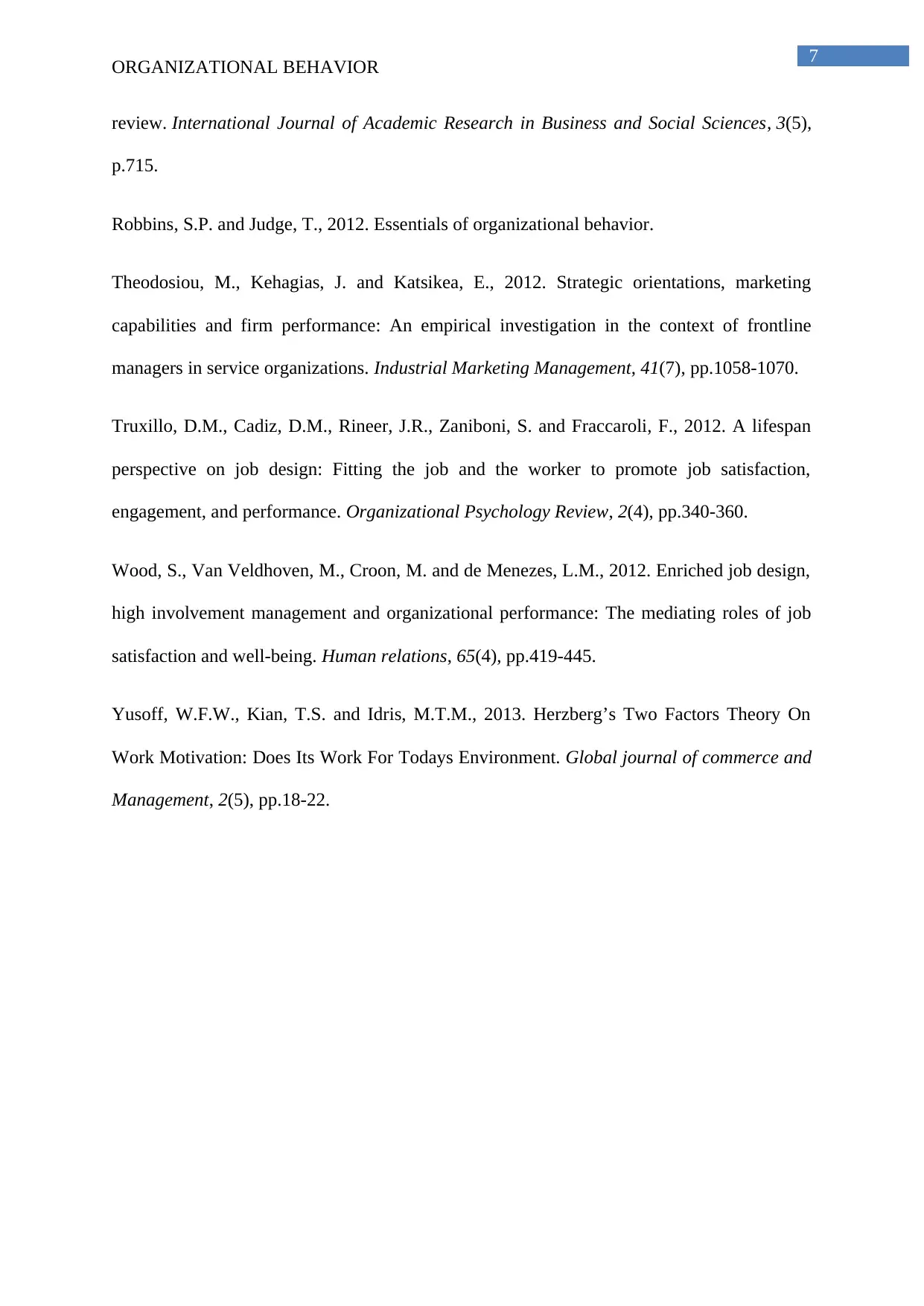
7
ORGANIZATIONAL BEHAVIOR
review. International Journal of Academic Research in Business and Social Sciences, 3(5),
p.715.
Robbins, S.P. and Judge, T., 2012. Essentials of organizational behavior.
Theodosiou, M., Kehagias, J. and Katsikea, E., 2012. Strategic orientations, marketing
capabilities and firm performance: An empirical investigation in the context of frontline
managers in service organizations. Industrial Marketing Management, 41(7), pp.1058-1070.
Truxillo, D.M., Cadiz, D.M., Rineer, J.R., Zaniboni, S. and Fraccaroli, F., 2012. A lifespan
perspective on job design: Fitting the job and the worker to promote job satisfaction,
engagement, and performance. Organizational Psychology Review, 2(4), pp.340-360.
Wood, S., Van Veldhoven, M., Croon, M. and de Menezes, L.M., 2012. Enriched job design,
high involvement management and organizational performance: The mediating roles of job
satisfaction and well-being. Human relations, 65(4), pp.419-445.
Yusoff, W.F.W., Kian, T.S. and Idris, M.T.M., 2013. Herzberg’s Two Factors Theory On
Work Motivation: Does Its Work For Todays Environment. Global journal of commerce and
Management, 2(5), pp.18-22.
ORGANIZATIONAL BEHAVIOR
review. International Journal of Academic Research in Business and Social Sciences, 3(5),
p.715.
Robbins, S.P. and Judge, T., 2012. Essentials of organizational behavior.
Theodosiou, M., Kehagias, J. and Katsikea, E., 2012. Strategic orientations, marketing
capabilities and firm performance: An empirical investigation in the context of frontline
managers in service organizations. Industrial Marketing Management, 41(7), pp.1058-1070.
Truxillo, D.M., Cadiz, D.M., Rineer, J.R., Zaniboni, S. and Fraccaroli, F., 2012. A lifespan
perspective on job design: Fitting the job and the worker to promote job satisfaction,
engagement, and performance. Organizational Psychology Review, 2(4), pp.340-360.
Wood, S., Van Veldhoven, M., Croon, M. and de Menezes, L.M., 2012. Enriched job design,
high involvement management and organizational performance: The mediating roles of job
satisfaction and well-being. Human relations, 65(4), pp.419-445.
Yusoff, W.F.W., Kian, T.S. and Idris, M.T.M., 2013. Herzberg’s Two Factors Theory On
Work Motivation: Does Its Work For Todays Environment. Global journal of commerce and
Management, 2(5), pp.18-22.
1 out of 8
Related Documents
Your All-in-One AI-Powered Toolkit for Academic Success.
+13062052269
info@desklib.com
Available 24*7 on WhatsApp / Email
![[object Object]](/_next/static/media/star-bottom.7253800d.svg)
Unlock your academic potential
Copyright © 2020–2025 A2Z Services. All Rights Reserved. Developed and managed by ZUCOL.





